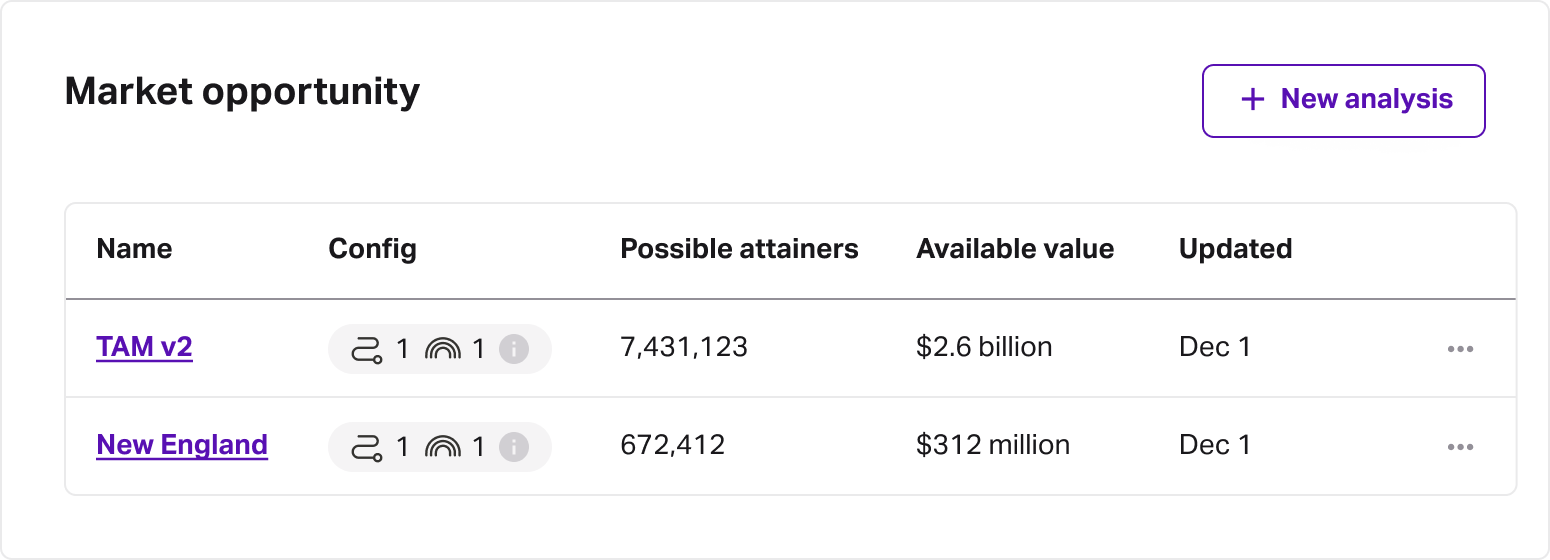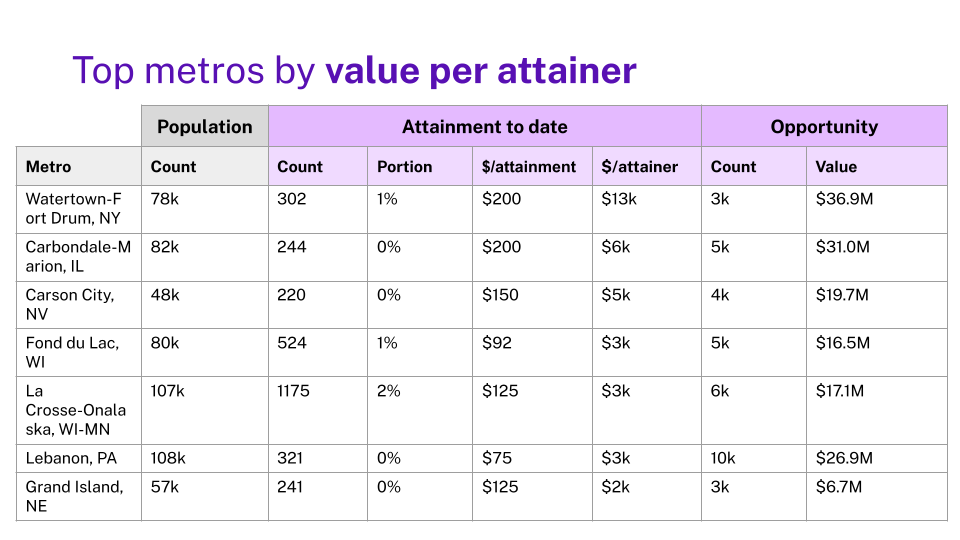Market Opportunity Analysis
Market Opportunity Analysis reports help you identify actionable growth opportunities in your market.
Market Opportunity Analysis (MOA) reports overview
A Market Opportunity Analysis report allows you to compute your current penetration and the uncaptured opportunity in your market. With this report, you can see the number and locations of remaining likely customers, which can help you focus your marketing and development efforts more efficiently.
With a Faraday MOA report, you can:
- Assess the total addressable market and penetration rates at a variety of geographic levels.
- Identify high-potential regions for expansion.
- Track changes over time to refine market strategies.
- Generate shareable reports in Google Sheets and Google Slides.
Our reports are designed for both technical users integrating MOA into their systems and non-technical stakeholders who need to interpret the results. The following sections outline how to configure your pipeline, request a report, and interpret the output—whether via the Faraday app or API.
👍Key takeaway: MOA reports
Traditionally, MOA tells you how many of your target customers are left, but with Faraday’s that’s not all. Thanks to our robust suite of predictive tools, we can also anticipate where they are and what kind of people they are. Moreover, these assessments can be easily refreshed every month and provide deeper, more nuanced insights than with other, more traditional MOA models.
How it works
Faraday’s MOA process starts with a deep dive into your current customer base. Through this analysis, we uncover patterns in purchasing behaviors, geographic preferences, and lifetime value, which helps us build a detailed profile of your ideal customer and understand where your business already excels.
Then, we expand the lens. Using the proprietary Faraday Identity Graph (FIG), we assess the broader U.S. market and compare it to your ideal customer profile. These models allow us to pinpoint where your best prospective customers are located, quantifying the untapped potential in specific regions (down to individual postal codes) and demographics.
MOAs can be created manually via the Faraday app or programmatically via the API. When enabled for an account, clients can generate, edit, and receive MOA reports directly, with refreshed results automatically emailed monthly.
What you need to do
1. Create a customer acquisition outcome
- Follow the outcome docs to set attainment = customers, eligibility = everyone (or a defined market), and no attrition.
2. (Optional) Create a Persona Set for richer insights.
3. Create or repurpose a Pipeline with the following setup:
- Population: Include: Everyone; Exclude: None (do not exclude attainers!)
- Payload: Include the outcome and optional persona set and/or cohorts.
- Important: If you're using a cohort in the analysis, it must be defined by an event stream. To calculate value-based opportunity, the event stream must contain a
valuefield (e.g.lifetime_spend,visits, etc.). If this is missing, the report will run but omit value calculations.
4. Ensure the pipeline is rendered (this happens automatically but may take a few minutes). You do not need a target; MOA uses the most recent scope rendering.
5. Check that feature flag** to ensure that market_opportunity_analyses.enabled = true is set.
- Allows clients to access MOA creation/editing in the UI
- Enables monthly report emails to account users
Creating an MOA report
In the Faraday app:
1. Navigate to your pipeline
2. Scroll to the Market Opportunity section
3. Click New analysis
4. Fill in the required fields (outcome, scope, persona set, etc.)
5. Save and wait for the report to process

MOAs run automatically once per month. To generate a fresh report manually, go to Chief, find the MOA, and click Resource Updated.
Via the API:
Get your production API key from the app (Settings → Account → API key → Production environment), then run:
curl --request POST \
--url https://api.faraday.ai/v1/market_opportunity_analyses \
--header 'Accept: application/json' \
--header 'Authorization: Bearer {API_TOKEN}' \
--header 'Content-Type: application/json' \
--data '{
"name": "string",
"outcome_id": {OUTCOME_ID},
"persona_id": {PERSONA_ID},
"persona_set_id": {PERSONA_SET_ID},
"scope_id": {SCOPE_ID}
}'
Additional docs can be found on our API reference page.
What you get back
Once your request is processed, Faraday returns a comprehensive set of insights about your target audience:
- Total market size and penetration rates
- High-opportunity geographies (down to ZIP code)
- Persona-level summaries of opportunity
- Match rate-adjusted metrics (e.g. attainer counts, cohort totals)
The following outputs are generated automatically:
- A table in your account’s
market_analysesdataset on BigQuery (if applicable) - A Google Sheets summary for detailed exploration
- A Google Slides deck for presentations
All assets are automatically shared with account users.

Understanding key MOA fields
MOA reports include several key fields that quantify your market reach and potential opportunity. These definitions reflect how they’re calculated in Faraday:
Portion
The share of attainers (customers) represented by a specific group, relative to the total.
- Example: In a Market analysis by persona, portion = attainers in this persona ÷ total attainers.
- Example: In Top states by number of attainers, portion = attainers in this state ÷ total attainers.
$/attainment
The average order value (AOV) — the average amount spent per individual purchase.
$/attainer
The average lifetime spend per attainer, calculated by summing each attainer’s total spend since becoming a customer (based on available data) and dividing by the total number of attainers.
- In practice, this represents LTV: total $ per customer across all purchases.
Attainer
An individual who meets the conditions defined in the outcome used for the MOA — most often a customer, but it can also represent other entities (e.g., leads) depending on the cohort used.
Opportunity Value
The estimated revenue remaining in the market if all possible attainers were converted into actual attainers.
Calculated as: remaining possible attainers × average $/attainer (or local AOV)
This value has no time limit; it reflects total uncaptured potential, not time-bound opportunity.
How Faraday does it differently
Unlike traditional MOA tools that rely on static demographics or generic TAM models, Faraday’s MOA uses predictive modeling powered by FIG to deliver deeper insights:
- Propensity modeling: Identifies future likely customers, not just historical lookalikes
- Persona analysis: Segments the market by behavioral personas—not just age or income
- Advanced analytics: Incorporates event stream data and value projections to prioritize efforts
You get actionable, market-specific intelligence that evolves with your customer base and market trends—not a one-time snapshot.